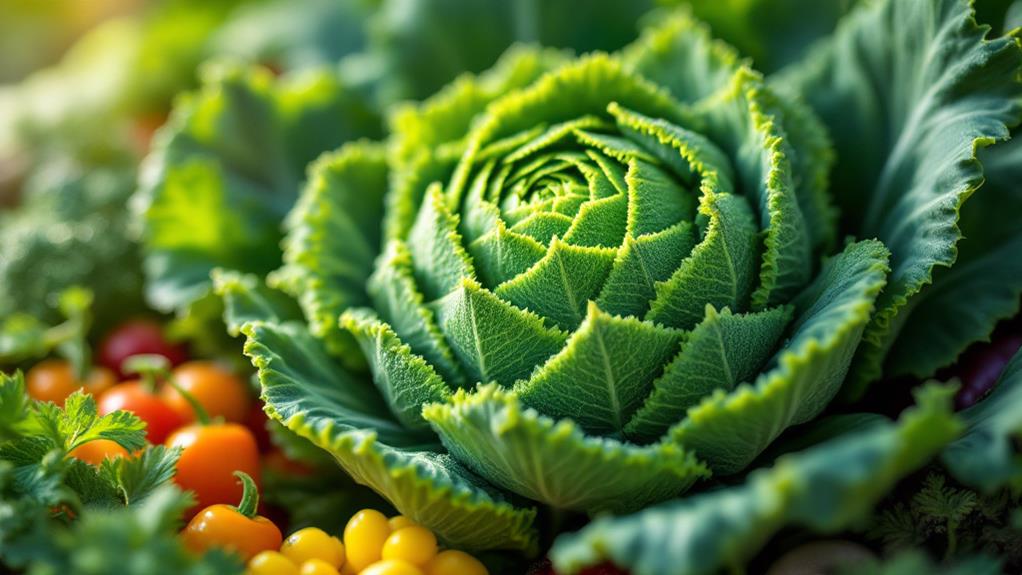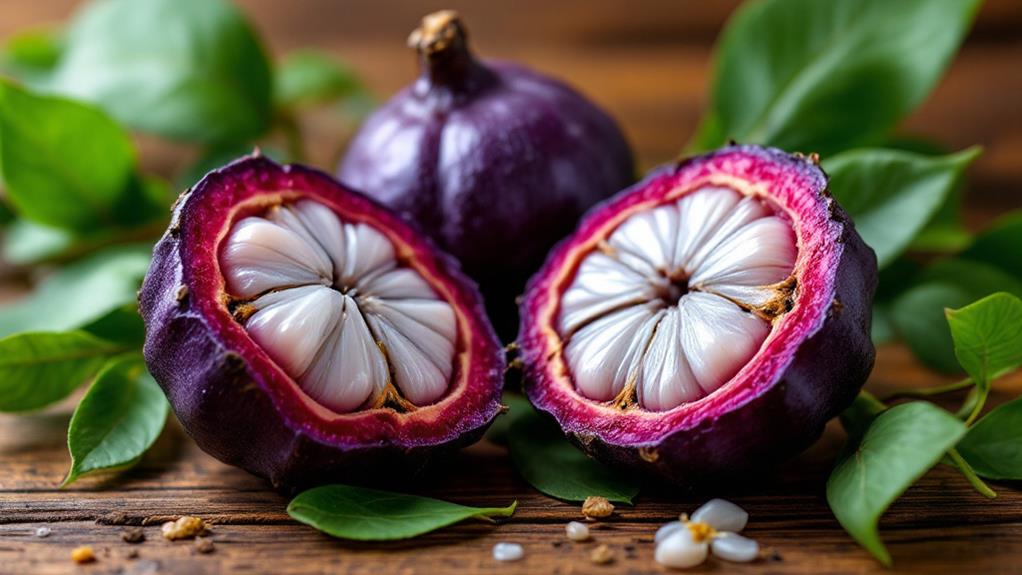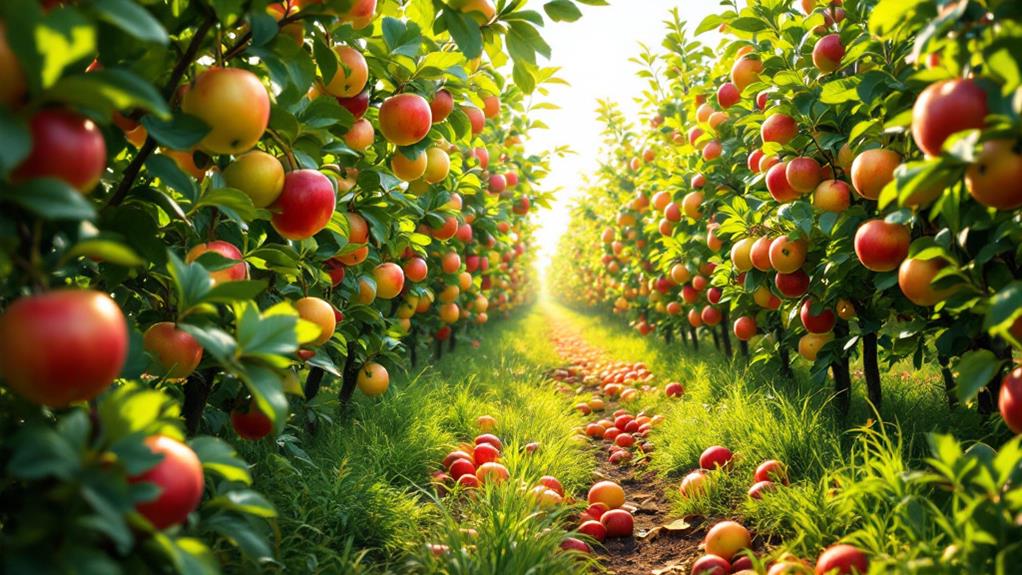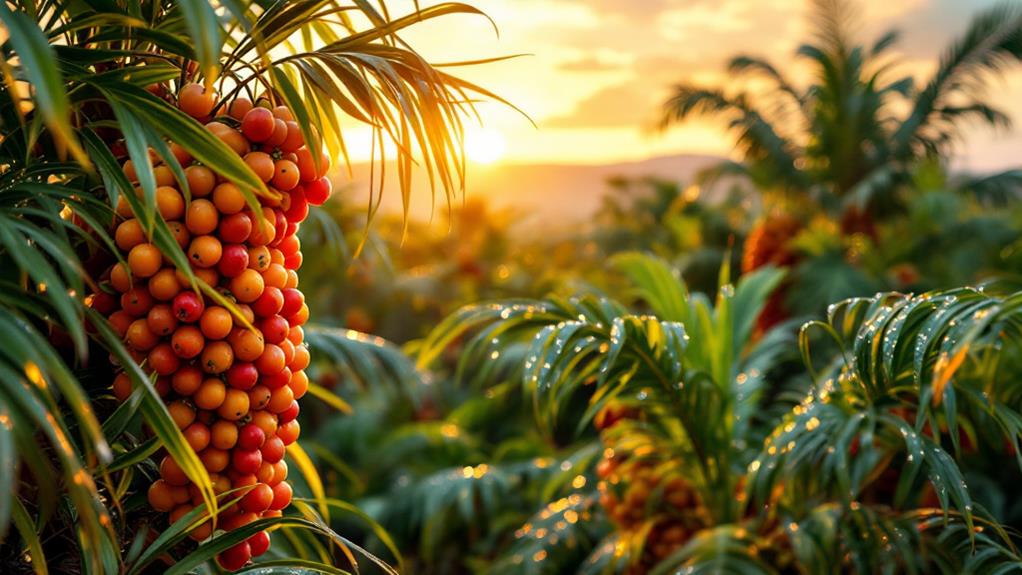Asian Fruits: Unique Facts and Exotic Flavors to Discover
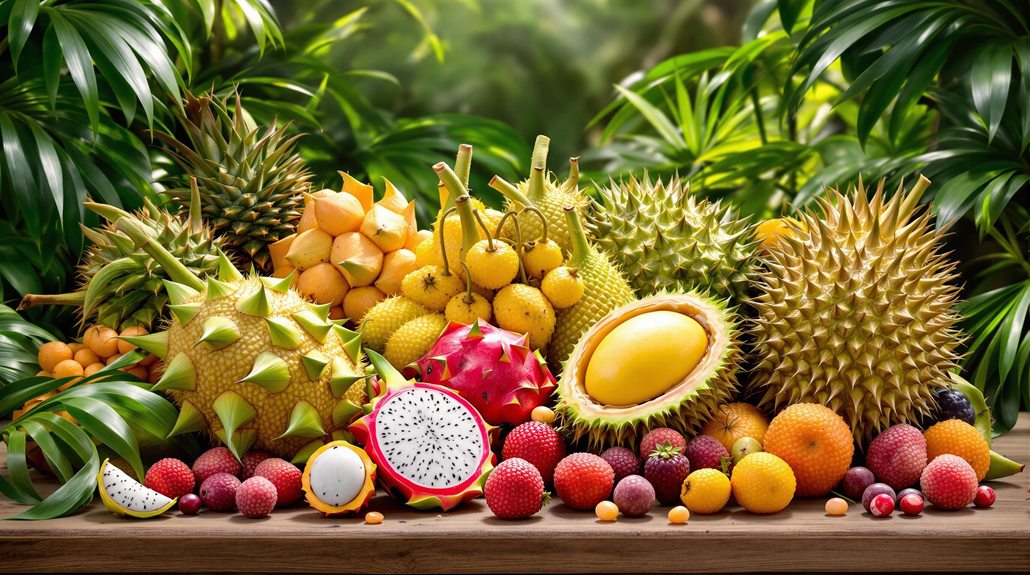
You're initiating a flavorful expedition through Asian fruits. Uncover the lively lychee with its sweet floral notes, or the rambutan, which surprises with a juicy center. Meet mangosteen, the "queen of fruits," delighting with its sweet and tangy balance. Ever heard of jackfruit? It's the largest tree-borne fruit and a popular meat substitute. Delight in dragon fruit's visually stunning pink exterior and mild sweetness. These fruits are rich in antioxidants, vitamins, and fiber, enhancing your health in delightful ways. Intrigued? There's so much more to investigate about their flavors, uses, and cultural significance just beyond the horizon.
Exploring Asian Fruit Varieties
When you investigate Asian fruit varieties, you'll uncover a world of unique flavors and textures. These tropical gems, like lychee and jackfruit, captivate with their exotic appeal. Lychee, with its bumpy red skin, offers a sweet floral flavor that makes it a seasonal favorite in China from May to July. You might find its taste reminiscent of a delicate perfume.
In Southeast Asia, rambutan and mangosteen are celebrated for their distinct profiles. Rambutan, with its hairy shell, hides a juicy, grape-like center that's both invigorating and intriguing. Meanwhile, mangosteen, often dubbed the "queen of fruits," delights with its sweet and tangy flavor.
Jackfruit stands out as the largest tree-borne fruit, reaching up to 80 pounds. It's versatile, serving as a meat substitute in vegan dishes when unripe, thanks to its fibrous texture. Dragon fruit, primarily grown in Vietnam, entices with its lively pink skin and mildly sweet flesh, making it a visual and culinary delight.
Don't overlook pomelo, the largest citrus fruit, known for its thick rind and sweet, invigorating taste. It's a staple in Southeast Asian salads and desserts, offering a burst of citrusy goodness.
Health Benefits of Exotic Fruits
While exploring the vibrant world of exotic fruits, you'll uncover not only their unique flavors but also their remarkable health benefits. Exotic fruits like mangosteen, rambutan, and jackfruit are packed with antioxidants, which promote general health and help reduce inflammation. These powerful compounds play an essential role in maintaining your body's resilience against various illnesses.
Many tropical fruits, such as guava and lychee, are high in vitamin C, improving your immune function and contributing to lively skin health. Incorporating these fruits into your diet can notably enhance your body's natural defenses. Furthermore, the dietary fiber found in dragon fruit and starfruit supports digestion and helps maintain gut health. A healthy gut is crucial for absorbing nutrients effectively and keeping your digestive system in top shape.
Consuming exotic fruits like longan and durian provides vital vitamins and minerals, including potassium, which is known to support heart health. Regularly eating these fruits can also improve your hydration due to their high water content, which is essential for general bodily functions. Embracing these exotic fruits in your diet offers a delicious way to elevate your overall health and well-being.
Unique Flavors to Savor
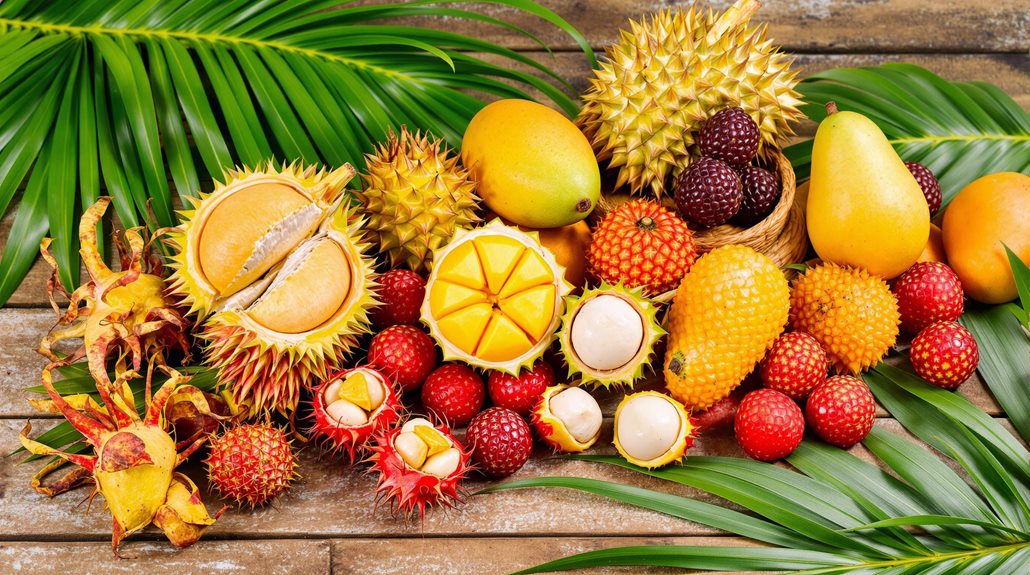
Engulf yourself in the delightful world of unique flavors that Asian exotic fruits offer. Imagine biting into a Mangosteen, the "queen of fruits," with its sweet and tangy flavor combining notes of lychee, peach, and vanilla. It's no wonder this fruit scores an impressive 8.9 out of 10 in taste. Then there's the Rambutan, with its bright red, hairy exterior hiding juicy white flesh. Its flavor is reminiscent of tropical grapes, earning it a taste score of 8.0.
Durian presents a more adventurous choice. Known as the "king of fruits," its flavor can be polarizing, ranging from sweet and custard-like to savory. Some adore its exotic taste, while others remain unconvinced, reflected in its varied taste scores between 8.2 and 2.4. For a versatile option, try Jackfruit. Its yellowish flesh, with a taste blending banana and pineapple, makes it perfect for both sweet and savory dishes, scoring 7.4.
Traditional Uses and Recipes
As you savor the unique flavors of Asian fruits, you'll find they also boast rich traditional uses and recipes that highlight their culinary versatility. Many Southeast Asian fruits, such as durian and mangosteen, are often used in traditional desserts like sticky rice and fruit salads. These dishes showcase their unique flavors and textures, creating delightful, exotic treats. Jackfruit, with its meaty texture, is a star in savory recipes. It's commonly prepared as a meat substitute in vegetarian curries and street food dishes, bringing a satisfying bite and subtle sweetness to the table.
Lychee and longan, celebrated for their floral sweetness, often find their way into revitalizing drinks and desserts. Imagine a fruit cocktail or sweet soup where their flavors shine through, offering a taste of the tropics in every sip. Coconut, a staple in many Asian cuisines, is indispensable in both sweet and savory dishes. From rich curries to creamy desserts, its versatility never ceases to amaze.
Embrace the spirit of seasonal fruit festivals across Southeast Asia, where local varieties take center stage. These festivals feature traditional recipes and culinary demonstrations, celebrating cultural heritage and community through the shared love of these exquisite fruits.
Tips for Selecting and Storing

Mastery in selecting and storing exotic Asian fruits can greatly improve your culinary experience. When choosing these flavorful delights, focus on lively colors, firm textures, and pleasant aromas. These indicators will guide you to fruits at their freshest state and peak ripeness. Be certain to select fruits that are free from bruises, mold, or decay, as this guarantees quality and helps avoid spoilage.
Once you've chosen your fruits, proper storage is key to extending their freshness. For fruits like mangoes and papayas, keep them at room temperature until they ripen. After they reach peak ripeness, refrigerate them to maintain their flavor and nutritional benefits. Tropical fruits such as rambutan and lychee thrive in breathable containers. Store these in a cool, dry place to prevent moisture buildup, which can lead to spoilage.
Cultural Significance of Asian Fruits
Asian fruits aren't just delicious; they're deeply woven into the cultural fabric of many societies. When you savor a lychee or a mangosteen, you're not just enjoying a treat; you're participating in a tradition. These fruits often star in traditional desserts and festive dishes, underscoring their cultural importance during celebrations and family gatherings. Durian and jackfruit, for example, are more than just exotic flavors; they hold symbolic meanings. Durian, often dubbed the "king of fruits," is a staple at special occasions, while jackfruit features prominently in regional festivals.
| Fruit | Cultural Significance |
|---|---|
| Lychee | Featured in traditional desserts and celebrations |
| Durian | Known as the "king of fruits," used in special occasions |
| Jackfruit | Integral to regional festivals and culinary traditions |
| Mangosteen | Celebrated for its flavor and cultural importance |
In Southeast Asia, regional festivals like Malaysia's Durian Festival celebrate the harvest, showcasing local varieties and culinary uses. Rambutan and longan aren't just sweet; they're believed to promote health and wellness in traditional medicine. Seasonal availability influences cultural practices, filling local markets with fresh produce, a reflection of the region's rich agricultural heritage. These fruits, deeply ingrained in cultural norms, reflect traditions and values that transcend generations.

